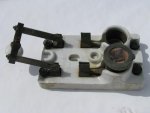Look at post #5 in this thread.
http://forums.mikeholt.com/showthread.php?t=99204
Same thing infinity posted. This is what they are referring to.
As opposed to this, which is NOT a "snap" switch:

It's a reference to a relic in what used to be used before CBs became the norm. But for all intents, the purpose of this code section is, as I was told many moons ago, to force people to no longer use those old snap switch fused panels on larger services, so they added the rule maxing it out at 200A. It basically removed them from being usable on commercial and industrial applications where there was more fault current available. Those snap switches were not automatic, so they had no coordinated interrupt capacity, they relied on the fuses. It was therefore theoretically possible to open them under fault conditions (while waiting for the fuse to clear for instance) that could cause the switch to explode on you in the process.
I was involved in a project at a US Steel plant in the late 70s where we had to go through and rip out all of these we could find, working or not. When they were installed around WWII, the service transformers for the offices where they were used were separate from the service drops for the mill itself, but had been combined to save money in the 60s. So the fault current available on them was >30kA, as opposed to being under 10kA originally.

